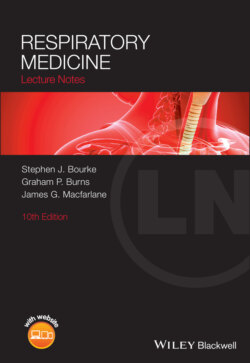Читать книгу Respiratory Medicine - Stephen J. Bourke - Страница 87
Single‐breath method
ОглавлениеThe single‐breath method is shown in Fig. 3.8. The patient inspires a gas mixture of helium and carbon monoxide, holds their breath for 10 seconds and then breathes out. An initial volume equivalent to the dead space (the part of the respiratory tract not involved in gas exchange) is discarded and a sample of the expired gas is collected and analysed for alveolar concentrations of helium and carbon monoxide. The change in concentration of helium (which, being an inert gas, is neither absorbed nor metabolised) between the inspired and alveolar samples is the result of gas dilution and gives a measurement of the alveolar gas volume (VA). The expired concentration of carbon monoxide is also lower than the inspired level, but the fall is proportionately greater than in the case of helium because some of the carbon monoxide is absorbed into the bloodstream. The rate of uptake of carbon monoxide can then be calculated as the uptake per minute per unit of partial pressure of carbon monoxide (mmol/min/kPa).
Many factors influence TLCO, including:
V/Q imbalance (disturbed in many diseases, affecting lung parenchyma or vasculature)
the surface area of the membrane for diffusion (reduced in emphysema)Figure 3.8 Measurement of transfer factor by the single‐breath method. Schematic representation of the helium and carbon monoxide concentrations in the inspired mixture and in alveolar air during breath holding.
the thickness of the alveolar capillary membrane (increased in fibrotic lung disease)
the pulmonary capillary blood volume (increased in high cardiac output states)
the haemoglobin concentration.
Free blood in the lungs from pulmonary haemorrhage will also avidly absorb carbon monoxide and lead to an elevated TLCO.
